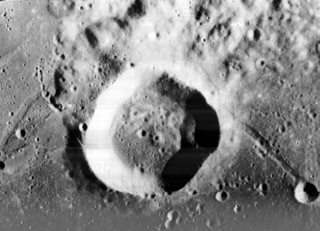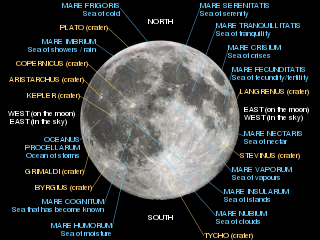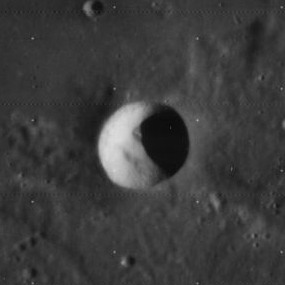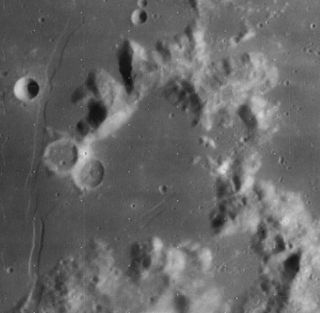 Apollo 16 image | |
| Coordinates | 8°36′S41°12′E / 8.6°S 41.2°E Coordinates: 8°36′S41°12′E / 8.6°S 41.2°E |
|---|---|
| Diameter | 74 km |
| Depth | 2.3 km |
| Colongitude | 318° at sunrise |
| Eponym | Johannes Gutenberg |
Gutenberg is a lunar impact crater that lies along the west edge of Mare Fecunditatis, in the eastern part of the visible Moon. It is named after German inventor Johannes Gutenberg. [1] To the southeast are the craters Goclenius, Magelhaens and Colombo. To the west-southwest is the crater Gaudibert, across the Montes Pyrenaeus that run south from Gutenberg.

Lunar craters are impact craters on Earth's Moon. The Moon's surface has many craters, almost all of which were formed by impacts.

An impact crater is an approximately circular depression in the surface of a planet, moon, or other solid body in the Solar System or elsewhere, formed by the hypervelocity impact of a smaller body. In contrast to volcanic craters, which result from explosion or internal collapse, impact craters typically have raised rims and floors that are lower in elevation than the surrounding terrain. Impact craters range from small, simple, bowl-shaped depressions to large, complex, multi-ringed impact basins. Meteor Crater is a well-known example of a small impact crater on Earth.

Mare Fecunditatis is a lunar mare which is 840 km in diameter.
Contents

The rim of Gutenberg is worn and eroded, most notably in the east where it is broken by the overlapping crater Gutenberg E. This crater in turn has gaps in its southeast and southwest rims, forming a passage to the lunar mare to the east. There are also clefts and valleys in the southern rim where it joins Gutenberg C. The crater Gutenberg A intrudes into the southwest rim.

The lunar maria are large, dark, basaltic plains on Earth's Moon, formed by ancient volcanic eruptions. They were dubbed maria, Latin for "seas", by early astronomers who mistook them for actual seas. They are less reflective than the "highlands" as a result of their iron-rich composition, and hence appear dark to the naked eye. The maria cover about 16% of the lunar surface, mostly on the side visible from Earth. The few maria on the far side are much smaller, residing mostly in very large craters. The traditional nomenclature for the Moon also includes one oceanus (ocean), as well as features with the names lacus (lake), palus (marsh), and sinus (bay). The last three are smaller than maria, but have the same nature and characteristics.
The floors of Gutenberg and Gutenberg E have been flooded in the past by lava, forming a relatively flat plain across the bottom. This surface is broken across the northeast by a pair of clefts that form a part of the Rimae Goclenius. These extend northwest from the Goclenius region. The central rise of Gutenberg is a semi-circular range of hills that are the most prominent in the south, and the concave part lies open to the east. The floor is otherwise not marred by any significant craters.

Lava is molten rock generated by geothermal energy and expelled through fractures in planetary crust or in an eruption, usually at temperatures from 700 to 1,200 °C. The structures resulting from subsequent solidification and cooling are also sometimes described as lava. The molten rock is formed in the interior of some planets, including Earth, and some of their satellites, though such material located below the crust is referred to by other terms.





















